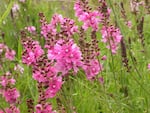A Northwest wildflower that was classified 30 years ago as threatened under the Endangered Species Act no longer needs that protection.
The U.S. Fish and Wildlife Service announced Monday that Nelson’s checker-mallow will be coming off the Endangered Species list 30 days after the upcoming notice appears in the Federal Register.

Nelson’s checker-mallow grows from south of Corvallis to north of Vancouver.
Courtesy of the U.S. Forest Service
Nelson’s checker-mallow grows 15- to 40-inch tall spikes of deep pink flowers that dot prairies but also wetlands, edges of woodlands and riparian areas in the Willamette Valley and Coast Range. It was placed on the Endangered Species List in 1993, threatened by habitat loss caused by agricultural development, stream alterations that limited water to meadows, recreational activities and roadside spraying. Also, the introduction of trees and shrubs reduced the plant’s habitat.
But today 38 independent populations are thriving in more than 50 locations in the Willamette Valley and Coast Range from south of Corvallis to north of Vancouver in Washington state, the wildlife service said. Some sites are publicly owned, have been purchased by conservation groups or are enrolled in conservation programs.
The wildlife service expects the number of locations where Nelson’s checker-mallow now grows to remain constant for the foreseeable future.
The wildlife service said that landowners and more than a dozen federal and state entities – including the Confederated Tribes of the Grand Ronde, The Nature Conservancy, Native Plant Society of Oregon, Oregon State University, Oregon Department of Forestry and the Oregon Department of Agriculture – contributed to the recovery of Nelson’s checker-mallow.
Noah Greenwald, endangered species director at the Center for Biological Diversity, praised that cooperation, saying he was “overjoyed” with the plant’s recovery.
“The Endangered Species Act and a tremendous amount of effort has led to restoration of western Oregon and Washington prairies, which brought the Nelson’s checker-mallow back from the brink of extinction,” Greenwald told the Capital Chronicle. “But just a tiny fraction of these prairies have been restored, so we need to work urgently to protect this habitat and bring back more of the natural world.”

Nelson’s checker-mallow habitat ranges throughout the Willamette River Valley and up north into Southwest Washington.
Courtesy of U.S. Fish and Wildlife
Prairies require continued disturbance, for example from prescribed burning, to prevent them from turning into woodlands. Many landowners are helping with that by mowing areas and working with the wildlife service to maintain this habitat, the service said.
That work has helped some other prairie plants recover. The Golden paintbrush, which has 12-inch tall spears with golden yellow leaves, was delisted in July, and Bradshaw’s lomatium, with clusters of small yellow flowers, was delisted in 2022. The fourth Oregon plant that’s recovered is the water howellia, an aquatic plant that grows up to 2 feet tall and was delisted in 2021. Other species – Willamette daisy, Kincaid’s lupine, Taylor’s checkerspot butterfly and Fender’s blue butterfly – that are listed under the Endangered Species Act have recently been downlisted from endangered to threatened.
The delisting of Nelson’s checker-mallow – and the Golden paintbrush – coincide with the 50th anniversary this year of the Endangered Species Act. More than 100 species have been delisted or downlisted from endangered to threatened since the act was passed by Congress. Yet many remain listed as threatened or endangered. In Oregon, 15 plants remain on the list, according to Jodie Delavan, a spokesperson with the U.S. Fish and Wildlife Service.
This story was originally published by the Oregon Capital Chronicle. Oregon Capital Chronicle is part of States Newsroom, a network of news bureaus supported by grants and a coalition of donors as a 501c(3) public charity. Oregon Capital Chronicle maintains editorial independence. Contact Editor Lynne Terry for questions: info@oregoncapitalchronicle.com. Follow Oregon Capital Chronicle on Facebook and Twitter.